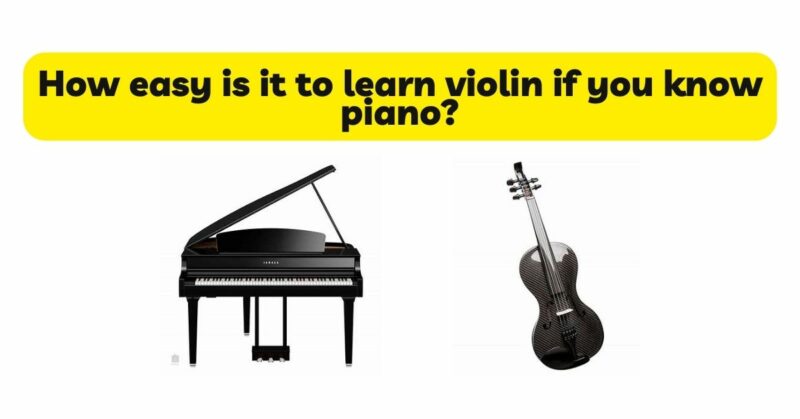Music enthusiasts who have already mastered one instrument often find themselves intrigued by the prospect of learning a new one. For those who have already gained proficiency in playing the piano, venturing into the world of the violin can be an exciting challenge. In this article, we will delve into the journey of transitioning from piano to violin, examining the similarities, differences, and potential advantages that pianists may have when learning the violin. By exploring these aspects, we aim to provide a comprehensive analysis of how easy or challenging it is to learn the violin if you already know how to play the piano.
Technical Advantages:
One advantage that piano players possess when learning the violin is a solid foundation in music theory and a developed sense of rhythm. Understanding concepts such as scales, key signatures, time signatures, and intervals can significantly ease the process of learning a new instrument. Pianists are already familiar with reading sheet music, recognizing note values, and understanding musical phrasing. These skills transfer seamlessly to the violin, reducing the learning curve and allowing pianists to focus more on the instrument-specific techniques.
Transferable Skills:
Piano players often have well-developed finger dexterity and coordination, which can be advantageous when learning the violin. The ability to play polyphonic music on the piano can translate into a better understanding of multiple voices and harmonies on the violin. Furthermore, piano players are accustomed to independent hand movements, which is crucial when mastering the left hand fingerings and the right hand bowing technique on the violin. The experience of using different fingerings for different keys on the piano can also aid in adapting to the various positions and fingerings required on the violin’s fingerboard.
Ear Training and Pitch Awareness:
Piano players who have honed their listening skills through ear training exercises can have a head start in developing a keen sense of pitch on the violin. Being able to recognize and reproduce accurate pitches, intervals, and melodies can significantly enhance the learning process. While the piano provides fixed pitch reference points, the violin’s ability to produce subtle variations in pitch requires a more refined ear. Nevertheless, pianists may find it easier to grasp the concept of intonation and adjust their finger placements accordingly.
Bow Technique and Articulation:
One of the key challenges for piano players transitioning to the violin is developing proper bowing technique. The bow is a fundamental element of violin playing, and producing a good tone requires a nuanced understanding of bow pressure, speed, and contact point. Pianists accustomed to producing sound through keystrokes may find it initially challenging to adapt to the bow’s delicate control. However, the finger independence and hand-eye coordination developed while playing the piano can be advantageous when learning to manipulate the bow on the violin. With time and practice, piano players can acquire the necessary bowing skills and achieve a beautiful tone on the violin.
Posture and Physical Adjustments:
While pianists may have an advantage in terms of finger dexterity, the transition to the violin requires adjusting to a different physical posture. The piano allows for a seated position with relaxed arms and hands, while the violin demands a standing position with a specific arm and hand position, along with proper shoulder and chin rest placement. Pianists must adapt to holding the violin with the chin and balancing its weight using the left hand, which may require some time and adjustment. Developing the necessary muscle strength and endurance for violin playing can be a new physical challenge for pianists, but with consistent practice, they can overcome these obstacles.
Mindset and Learning Approach:
Transitioning from piano to violin requires a flexible mindset and a willingness to embrace the unique characteristics of the new instrument. While there may be similarities and transferable skills, it is important to approach the violin as a distinct instrument with its own techniques and challenges. Recognizing that the learning process will require time, patience, and dedicated practice can help pianists navigate the journey more effectively. Seeking guidance from a qualified violin teacher who understands the specific needs and challenges faced by pianists transitioning to the violin can also be highly beneficial.
Conclusion:
Learning the violin after acquiring proficiency in playing the piano can be an exciting and rewarding endeavor. The transferable skills, musical knowledge, and ear training developed through piano playing provide a solid foundation for learning the violin. Pianists have advantages in music theory, finger dexterity, coordination, and pitch awareness, which can facilitate the learning process. However, it is important to acknowledge that the transition to the violin requires adjustments in posture, bowing technique, and physicality. By adopting a flexible mindset, seeking proper guidance, and dedicating focused practice, pianists can embark on a successful journey in mastering the violin. The combination of piano and violin proficiency opens up new musical horizons, allowing musicians to explore and express their creativity in diverse ways.

